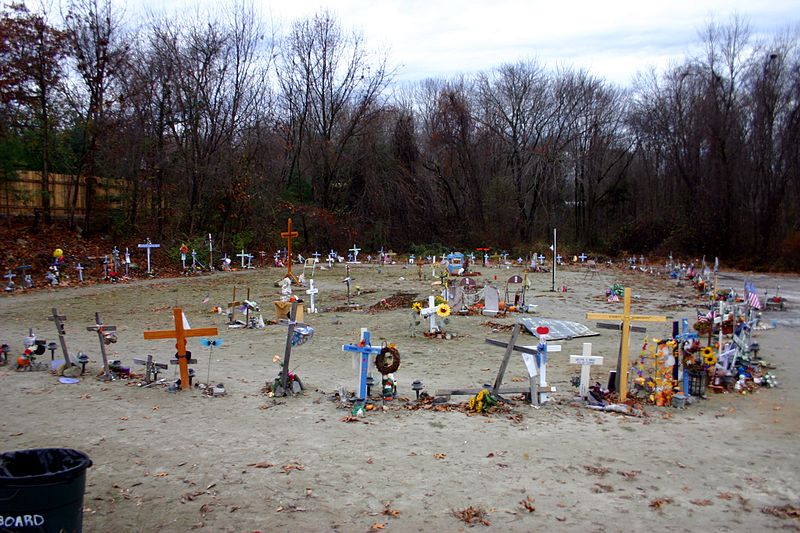Monday, April 30, 2012
Crazy L.A. Gun Fight Erupts During Riot
Tuesday, April 3, 2012
The Station Nightclub Fire
The Station nightclub fire was the fourth deadliest nightclub fire in American history, killing 100 people. The fire began at 11:07 PM EST, on Thursday, February 20, 2003, at The Station, a glam metal and rock n roll themed nightclub located at 211 Cowesett Avenue in West Warwick, Rhode Island.
The fire was caused by pyrotechnics set off by the tour manager of the evening's headlining band, Great White, which ignited flammable sound insulation foam in the walls and ceilings surrounding the stage. A fast-moving fire engulfed the club in 5½ minutes. Some 230 people were injured and another 132 escaped uninjured. Video footage of the fire shows its initial growth, billowing smoke that quickly made escape impossible, and the exit blockage that further hindered evacuation.
Out of 430 people: 100 fatalities, 115 required hospitalization

Number of victims found by location (main exit at bottom-center)

SUMMARY AND RECOMMENDATIONS
According to the computer predictions, many of the occupants had less than 90 seconds after
ignition to exit the structure. The quickly spreading fire and rapid production of smoke led to high
temperatures and low oxygen levels throughout most of the simulated nightclub. The exceptions were
a few areas close to the floor and near the open windows of the main bar room and the open doorway
to the main entry foyer. In these areas air from outside the structure was being drawn in providing a
more tenable environment and more time for escape.
The FDS simulation predicted rapid fire growth due to the burning of the convoluted polyurethane
foam. The simulation is consistent with the video record during the early stages of fire development.
The conditions in the actual nightclub transitioned from a fire within a compartment to a fully
involved wood structure fire burning in void spaces, the attic area, structural elements, and roofing
materials. In the computer simulation, such regions and materials were not included, which led to a
diminishing of the fire after 250 seconds as the fuel was consumed.
The simulation of the mockup experiments and this reconstruction also demonstrated difficulties in
modeling the pyrolysis of the foam and carpet. The low density foam burned quickly with little char
or residue and was hard to model as a simple fuel surface. As the carpet burned, portions of the
carpet pile melted and the melt pool exhibited more complex burning than a simple fuel surface.
In the simulation of the full nightclub equipped with sprinklers, examination of the predicted
temperature and the oxygen volume fractions showed tenable conditions would have existed over the
duration of the simulation (300 seconds), as the fire was fully extinguished approximately 114
seconds after ignition.
Based on the reconstruction of the fire using FDS and the findings of the technical investigation1,
NIST made a number of recommendations that were aimed at improving life safety in nightclubs.
Calling for changes to the national model building codes, the key recommendations included:
• requiring the installation of an NFPA 13 compliant automatic fire sprinkler system in
all new nightclubs regardless of size and in all nightclubs with an occupancy limit
greater than 100 people;
• clearly identifying and specifically forbidding materials that ignite easily and
propagate flames rapidly, such as non-fire retarded polyurethane foam, as an interior
finish material in all nightclubs;
• increasing the factor of safety for determining occupancy limits in all new and
existing nightclubs. These include setting a maximum permitted evacuation time (90
seconds for nightclubs similar in size to or smaller that The Station), calculating the
number of required exits and permitted occupancies (assuming that at least one exit
will be inaccessible during an emergency), increasing staff training and evacuation
planning, and improving means for occupants to locate emergency routes when
standard exit signs are obscured by smoke.
• conducting studies to better understand fire spread and suppression and human
behavior in emergency situations, to predict the impact of building design on safe
egress in emergencies.

The fire at 40 seconds. Daniel Biechele is facing camera at right.
Raw Video before the fire

Subscribe to:
Posts (Atom)
Popular Posts
-
Surviving Argentina’s Economic Collapse Part 1-3 Hello, I thought I might post this info for your reading enjoyment. It is a series of artic...
-
Source It is a dramatic look at the tornado that hit one week ago today, unlike any we've seen before. The video shows the tor...
-
Here is a web page founded by a survivor of the Balkan War SHTF School
-
Epic story of about 20 families that uprooted from suburbia and made their homes for good in one of the most blighted neighborhoods in the U...
Labels
AMOK
(1)
Apocalyptic New York Legal Manual
(1)
Argentina Economic Collapse
(1)
Balkan War
(1)
Bug Out Bags
(1)
Bunkers
(1)
Farming
(1)
Fire
(1)
Flood
(3)
Food Shelf Life
(1)
food shortage
(1)
Fukushima
(1)
Hurricane Katrina
(1)
Industrial explosion
(1)
LA Riots
(1)
Medical
(1)
Survival Gear
(1)
Survival Skills
(1)
Survivalist
(3)
Surviving Disasters
(3)
Tornado
(1)
tsunami
(5)
tsunami 2004
(1)
Urban Farming
(1)
vehicle
(1)
Weapons
(1)